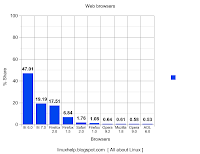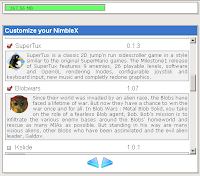GNOME is a popular, multi-platform desktop environment which focuses on ease of use, stability, and first class internationalization and accessibility support. GNOME rolls out a new version of its ever popular Desktop every six months. And in keeping with its commitment, it has yet again made available the newest release which is GNOME ver 2.20.
This begs the question as to what is new in GNOME 2.20. There are a number of new features. But most of them are subtle in nature and are not conspicuous to the end user. Here is a concise list of the new features in GNOME 2.20.
Evolution enhancements
- Gives an attachment reminder to the user if he tries to send a mail without any attachments but certain words in his mail indicate that he has attached a file to the mail.
- Backup all the mails and profiles in the Evolution client with the click of a button.
- A new mail notification icon and many other tiny miscellaneous enhancements.
Epiphany Web browser enhancements - More intuitive inline completion in the address bar
Image viewer enhancements
- Eye of Gnome (EOG) has a menu which allows you to open an image using another software program such as Gimp, Fspot, a web browser or G-thumb while viewing the image using eog. And if the image is modified, the modifications are updated in the eog in real time.
- The new image properties dialog provides easy access to basic information and metadata for your images, and now includes XMP (Extensible Metadata Platform) data that your camera or software might store in your image files, along with the existing EXIF data. This might include location, copyright information, license, and tags.
Evince PDF viewer
Supports interactive PDF forms. That is forms which allow you to enter data and then which can be send to print. Evince's page rendering features are also noticeably faster.
Great media player enhancement
Totem is the default media player in GNOME. In the new release, totem will search for and install all the required media codecs - even the non-free ones if it finds that the media file requires additional codecs. This is a very cool feature and will do away with all the manual installations required to make Linux more multimedia friendly.
 Fig: Totem now offers to install the proprietary codecs
Fig: Totem now offers to install the proprietary codecs
Notes synchronization
Tomboy now supports saving and retrieving notes stored in a remote location via its WebDav framework or SSH. This means that it is now possible to synchronize all your notes say between your home and office machines.
Search integrated in the File chooser dialog
This redesigned dialog now allows you to search for files using Desktop search systems such as Beagle or tracker. This makes it much more easier to open your files.
Nautilus enhancements
- A pie graph incorporated into the Nautilus file properties window makes it much more intuitive.
- File manager can now read EXIF data from digital cameras and will automatically orient and display the thumbnails of images.
A new control panel
GNOME 2.20 sports a new appearance control panel which allows you to change various properties such as themes, background images, fonts and such from a single interface. Till now each of these options had their own individual dialogs but not anymore.
Other enhancements
Improved GNOME keyring system providing you with a few new conveniences. I have not used the GNOME keyring yet so can't comment on it.
GNOME help browser called Yelp now sports a much more pleasing style and layout.
Apart from all this there are a number of other minor enhancements all round.
In the system administration side, GNOME offers an improved Lock down and user profile editor as well as incorporating better auditing support and roll based access control in Gnome display manager (GDM).
Having said that, the number one feature which excites me as an end user is the totem's built-in feature of pulling in and
installing all the required codecs to play any media file. I guess with this, one can finally say goodbye to poor out of the box support for video and audio files in Linux.













 Who wouldn't like to spruce up their desktop ... like changing the theme to one of your liking, changing the look of the icons, and at the most basic level, changing the desktop wallpaper. And Linux desktops are very flexible in allowing you to change every aspect of its look to your liking. So much that there are projects which allow you to make your Linux desktop (be it Gnome or KDE)
Who wouldn't like to spruce up their desktop ... like changing the theme to one of your liking, changing the look of the icons, and at the most basic level, changing the desktop wallpaper. And Linux desktops are very flexible in allowing you to change every aspect of its look to your liking. So much that there are projects which allow you to make your Linux desktop (be it Gnome or KDE)